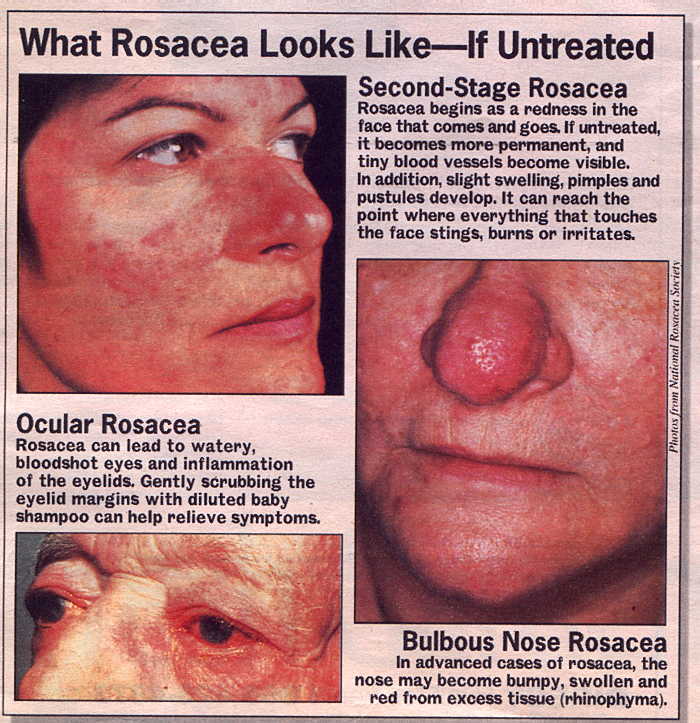Rosacea
From Wikiwel
Symptoms
Home remedies
Many patients use topical over-the-counter (OTC) agents to treat the symptoms of rosacea, either as an alternative to traditional prescriptions or to complement their prescription regimen. Increasingly, many of these OTC preparations contain herbs. Current estimates report that consumers in the US spend more than 21 billion dollars on alternative medicine and the use of herbal remedies saw an unprecedented 380% increase between 1990 and 1997.
- Licorice (Glycyrrhizin):Glycyrrhizinic acid has also been shown to improve dermatitis. In a study by Saeedi and associates, 2% glycyrrhizinic acid gel was reported to significantly decrease scores for erythema, edema, and itching over the 2-week treatment period.A recent study by Dieck and associates found that licochalcone A exhibited a potent anti-inflammatory action on a broad range of skin cells involved in skin inflammation.
- Feverfew (Tanacetum parthenium): One of the primary active components of feverfew, parthenolide, inhibits serotonin release from platelets. Feverfew inhibits 5-lipoxygenase and cyclooxygenase, resulting in a reduction in human blood platelet aggregation.In a recent study by Martin and associates, 45 days of treatment with 1% feverfew PFE (parthenolide-free extract) – Aveeno Daily Moisturizer Ultracalming, improved mild inflammatory acne by inhibiting the release of inflammatory markers from activated lymphocytes and reducing neutrophil chemotaxis. It is these immunomodulating properties that suggest feverfew PFE[TM] may be a useful treatment for rosacea.
- Green Tea (Camellia sinensis): The green tea derivatives epicatechin, epigallocatechin, epicatechin-3-gallate, and epigallocatechin-3-gallate possess well-documented anticarcinogenic properties and anti-inflammatory and antioxidant capabilities. These properties are especially useful for patients with rosacea as inherent sun sensitivity is a hallmark of the disease. The photoprotective properties of green tea may lessen reactivity to ultraviolet light, thereby reducing the signs and symptoms of rosacea. Moreover, green tea extract has been shown to reduce the disruption of the skin barrier often seen in patients with the disease.
- Oatmeal : First, oatmeal is a potent antipruritic. The moisturizing properties of colloidal oatmeal alleviate itch due to dry skin. These properties, in turn, promote protection of barrier function, which is often impaired in rosacea patients. Oatmeal also works as a skin protectant and enhancer of barrier function as the proteins and polysaccharides bind to skin to provide a protective barrier, while proteins buffer both acids and bases.
- Lavender (genus Lavandula): studies in animal models confirm the traditional use of Lavandula angustifolia for the treatment of painful and inflammatory conditions (including gastrointestinal disorders, migraines, and generalized pain).
- Chamomile (Matricaria recutita and Chamaemelum nobile)The active constituents of chamomile include the terpenoids (bisoprolol, matricin, chamazulene) and flavonoids (apigenin, luteolin). Studies have documented the anti-inflammatory and soothing effects of creams containing chamomile in patients with various inflammatory dermatoses. Chamomile is used in a variety of cosmetic products and as soothing compresses.
- Tea Tree Oil (Melaleuca alternifolia): In recent years it has become increasingly popular as an antimicrobial agent and has also been demonstrated to possess anti-inflammatory properties. Tea tree oil should be used with caution, however, as it has been associated with a wide variety of side effects including allergic contact dermatitis, systemic contact dermatitis, erythema, and systemic hypersensitivity reactions as well as conditions such as linear immunoglobulin A disease.
- Camphor Oil (Cinnamonum camphora) : Recently, camphor oil has been evaluated for its efficacy in treating the demodicoses that are frequently comorbid with rosacea. In a study by Morsy, marked reduction in the infestation density were noted following application of diluted camphor oil at concentrations of 20% to 25%. Caution is warranted with the use of camphor oil, however, as it is a known skin irritant.
Warnings
References
Medical Disclaimer
This information is not meant to be substituted for medical advice. Always consult a medical professional regarding any medical problems and before undertaking any treatment or dietary changes.
